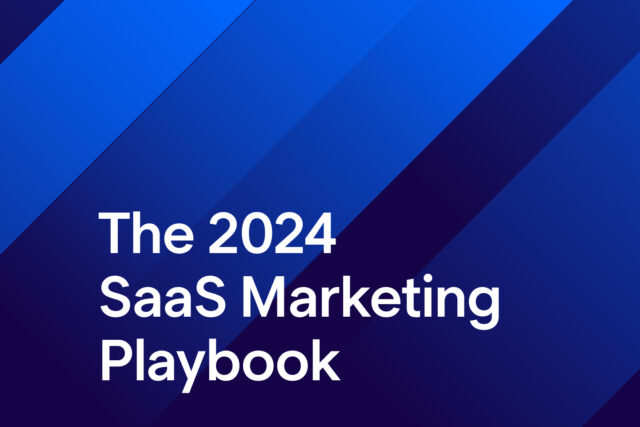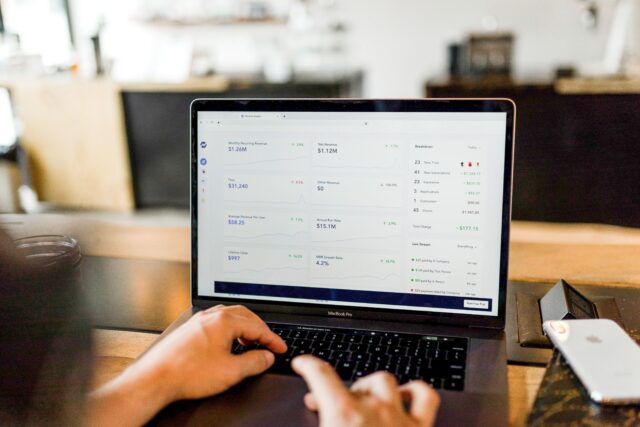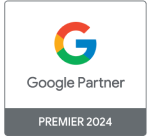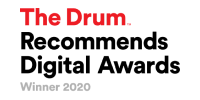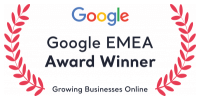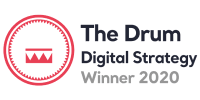Some of the key challenges unique to SaaS we’re going to discuss today are:
– SERP competition from aggregator and review sites
– A particular need to pay close attention to SERP intent when keyword targeting
– The long sales cycle
Creating a SaaS SEO Strategy
Lots of the fundamental process involved in creating an SEO strategy for a SaaS organisation doesn’t differ that much from any other industry.
Of course, it’s important that the foundational tenets of things such as on-page SEO, great content and EEAT signals, strong technical SEO, high authority and killer UX are adhered to, so this blog won’t be going into each of those in detail.
Instead, we’re going to look at aspects of SEO strategy development that require closer attention when working with SaaS specifically.
The discovery phase
This initial stage should be focused on gaining an in-depth understanding of the business, its products and solutions, the website, objectives and the industry as a whole. Ensure you fully understand what the products are used for and who they benefit.
With products that are often complex, SaaS as an industry can be jargon-heavy. Ensuring you have clarity on what the products do and how they help people will benefit you in the keyword targeting phase, whereby it’s essential that pages are geared up to target terms that your target audience are actually using – not internal jargon.
If possible, it’d be ideal to speak directly with customers, sales or customer support representatives so you can understand what questions commonly occur. We can then ensure that our site effectively provides this information.
You should use SEO research tools to build an understanding of the SEO situation the site is currently in. For example, was it impacted by historic algorithm updates? What’s the traffic trend over the last year? Has traffic dropped? Understanding the answers to SEO-focused questions like this can start to give some early steer to the creation of an SEO strategy.
At this stage you should have a clear understanding of who the competition is. Remember that SEO competitors are not always the same as your traditional business competitors.
Keyword and competitor research
During the discovery stage and in the process of gaining a deep understanding of the products, solutions and services the SaaS business provides, you’ll start to compile the beginnings of a keyword list.
Carry out keyword research, analyse the SERP and map your existing pages to target terms and identify new opportunities based on the organic gap with competitors.
It is at this stage that we start to see some SEO challenges relatively unique to SaaS.
High competition from B2B review sites
Many SaaS brands will face stiff competition from well-established organisations. Whilst this is true for any industry, many SaaS queries also face competition from powerful review and aggregator sites such as G2 and Capterra.
The term ‘employee engagement software’ illustrates this nicely, with G2, Capterra and, perhaps of less relevance, Forbes ranking for the head term ‘project management software’:
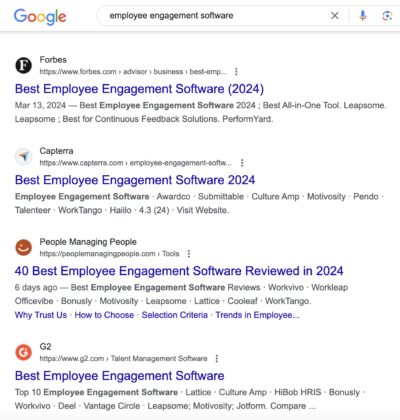
A quick look in Semrush highlights G2 and Capterra’s visibility for many of these ‘software’ head term queries.
Between them, G2 and Capterra are ranking in the US for 16,300 terms in the top three positions that contain the term ‘software’, with estimated monthly traffic of 260,600.
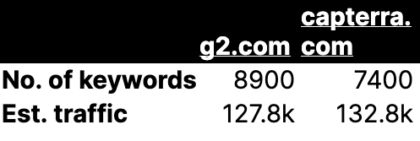
Example terms within these top three queries cross a lot of different industries within SaaS, such as:
– seo software
– event management software
– construction management software
– hvac software
– donor management software
In addition to these dedicated B2B software review sites, there are other affiliates with high authority but less expertise in the field ranking well, as in the above example with Forbes ranking above Capterra.
There’s been significant chatter in the industry recently about the continued strong visibility of publishing powerhouses like Forbes for an incredibly vast array of unrelated topics, to the detriment of higher quality, more relevant but smaller domains. Whilst there may be an algorithmic adjustment to return different results at some point, for now I think this lends extra importance to thoroughly assessing the SERPs when devising your keyword strategy. For many terms that you think your business should be ranking well for, it might prove very difficult due to the dominance of reviews, affiliate sites and other publishers.
What’s the impact of this on your SaaS SEO strategy?
For many software-based queries, these authoritative domains aren’t likely to budge from those top spots in the SERPs for those competitive, high volume head terms. Refining your keyword strategy to identify terms that you will have some chance of ranking for is important.
Make realistic appraisals of the SERP. Pay less attention to keyword volume and instead find more niche, long tail queries that are relevant for your offering and which – crucially – don’t return a SERP full of industry-dominating review sites.
When it comes to the likes of G2 and Capterra, as part of your wider strategy consider piggybacking on their authority and aim to build visibility and good reviews on these sites. In their create a profile section, G2 state that ‘86% of software buyers, across segments, use peer review sites when buying software’. It’s worth building a presence here, which may necessitate some paid advertising budget and a wider push for gaining customer reviews.
Creating content for each stage of the funnel
Ensuring we have content available at each stage of the funnel means that we can meet potential customers at each stage of their buying journey.
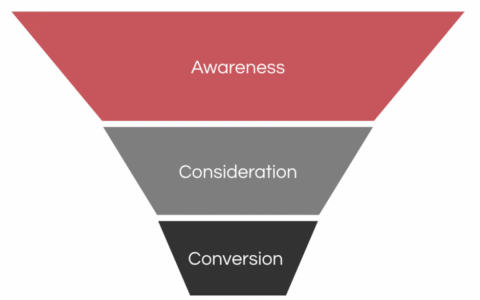
Awareness content
Top of funnel awareness content can attract users unfamiliar with the brand as they begin to research solutions to a problem, and will often be in the form of guides, articles or resources.
Rather than looking for a specific tool or solution, the user is looking for more general help and guidance. Whilst unlikely to convert users directly, awareness content is beneficial in building brand awareness and in building topical relevance and expertise, which could take the form of a content hub approach. Additionally, it’s crucial in building a strong internal link network to relevant pages lower down the funnel.
A good example here would be the query ‘how to project manage a remote team’.
Consideration content
This content will capture users who are aware of the brand and are evaluating various options.
These middle funnel searches often fall into one of the following types:
- Product category – your most basic searches like ‘project management software’
- Product category comparison – ‘organisational planning software’ vs ‘workforce planning software’
- Solution/industry – more specific searches that identify the buyer’s industry, e.g ‘project management tools for programmers’
- Features – specific features that the user is looking for, e.g ‘project management tool with file sharing’
- Integrations – how the software integrates other tools. Something like ‘help desk software with Salesforce integration’
Search intent is aligned with the different stages of the funnel and we need to ensure that we have content available for each stage.
When reviewing the SERPs, it’s important not just to gauge the competition, but to understand the type of content that’s ranking. Let’s use the SaaS query learning management system as an example and assume we want to rank our learning management system product page for that term and catch users towards the bottom of the funnel.
Searching from the UK, we see a few of the usual suspects in terms of affiliate tech publications ranking, but we also see direct competition in the form of several learning management system providers. As there’s actual software providers ranking here and not just hugely authoritative comparison sites and publishers, there’s potentially some opportunity to start ranking amongst these direct competitors.
Learning management system seems like it would be a good fit for a learning management system product page. But optimising a product page for this term and attempting to get that ranking shouldn’t necessarily be the automatic approach, as closer inspection of the SERP reveals that the content Google is returning for this query is mostly comparative or informational:
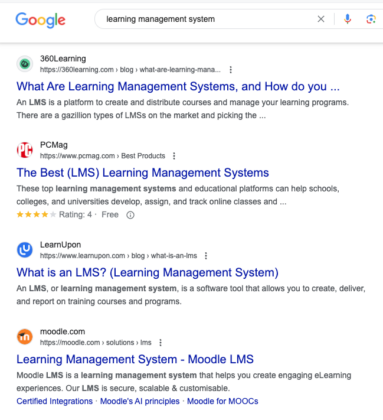
How does this impact the creation of a SaaS SEO strategy?
Just because you think a term closely matches your software product or solution, that doesn’t necessarily mean that Google is ranking product/solution pages for that query.
Inspection of the SERPs shows that the results are nearly entirely comparative or informational – aligned with the consideration stage and informational blogs as content type, rather than a conversion-focused product page.
In this case, it may be a better option to create an informational piece of content targeting this term and to target something else even more niche for the product/solution page.
Interestingly, I’ve seen some SaaS providers get around Google returning predominantly consideration level content and comparison/review articles by creating comparison articles themselves, which even list their competitors.
For the query ‘project management software’ SaaS vendors Monday and Hive each have ranking on page one a guide to the best project management software suppliers… with Monday and Hive unsurprisingly at the top of each respective list:
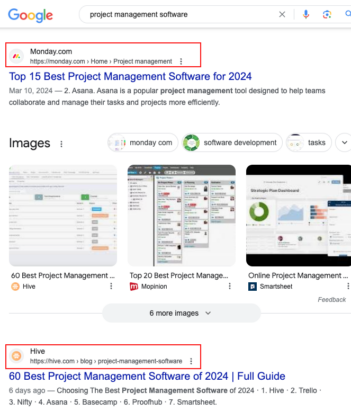
It’s a crafty way to maintain visibility for this high volume query, even if it does mean mentioning competitors.
Conversion content
Finally, the conversion stage of the funnel aligns with users who have a transactional search intent – consider any queries containing terms related to this, such as trial, demo, pricing, quote, case study etc. This is likely your product/solution pages. Don’t forget about your branded terms either, particularly if the brand has some traction: often there’s decent organic search volume for branded searches such as ‘what is x used for’, ‘is x a crm’, ‘how much does x cost’ etc. Make sure you have content available to answer these branded queries. If not, a review site likely will and may rank ahead of you.
Ensure you’re answering all the users’ questions around your products, showcase testimonials and reinforce strong EEAT signals to build customer trust. In the case of SaaS, this may be signing up for a demo or submitting a contact form.
This is also an opportunity to differentiate your product from alternative solutions. This is again something Monday are doing effectively, ranking for high volume terms such as ‘slack alternatives’: consider creating content about why your solution is a better alternative than competitors.
SaaS and the long sales cycle
As highlighted in Hallam’s 2024 SaaS playbook, in 2023 the B2B SaaS sales cycle was 43 days, up from 33 in 2020.
It’s particularly important for SaaS that we have content available at each stage of the funnel to be present at each stage of that lengthy decision making process, whether that’s comparison pieces, detailed guides, case studies or frequently asked questions relating to specific products.
At each stage of the funnel, we need to be clearly demonstrating Experience, Expertise, Authoritativeness and Trustworthiness. These EEAT signals show users – and google – that we’re a reputable source. With an increasing amount of AI content being generated, demonstrating that human level of expertise with trusted, authentic content is a key way SaaS brands can stand out. This is particularly important in the context of March 2024’s core update, which aims to address spammy and low quality content.
Summary
- Spend a lot of time on the discovery phase: avoid product-based jargon and uncover what people are actually searching for to find your solutions.
- Pay careful attention to the SERPs. Acknowledge strong competition from B2B review sites and find long tail alternatives to hugely competitive head terms.
- If you can’t beat them, join them: aim to build visibility on these platforms as part of your wider digital strategy.
- As well as gauging the competition, understand the type of content ranking. Avoid trying to rank a product/solution page for a particular term if the results are entirely informational.
- Create content to align with each stage of the funnel to support the long SaaS buying cycle. Consider creating your own software comparison and review content if relevant and deemed valuable.
SEO plays only part of the role in nurturing SaaS leads and should be part of a multi-channel digital strategy – get in touch with us today if we can help.


